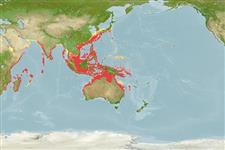Environment: milieu / climate zone / depth range / distribution range
Ökologie
seewasser demersal; tiefenbereich 10 - 155 m (Ref. 9824). Tropical; 37°N - 32°S, 35°E - 160°E
Indo-West Pacific: definitely recorded from Inhambane, Mozambique; throughout the Indian Ocean to Java, Sumatra, Viet Nam, Philippines, Taiwan, South Korea, Japan, and Lord Howe Island (Ref. 9824).
Size / Gewicht / Alter
Maturity: Lm ? range ? - ? cm
Max length : 27.0 cm TL Männchen/unbestimmt; (Ref. 9824)
Rückenflossenstacheln (insgesamt) : 0; Rückenflossenweichstrahlen (insgesamt) : 87 - 97; Afterflossenstacheln: 0; Afterflossenweichstrahlen: 61 - 73. Distinguished by cycloid scales on the ocular side, except for upper and lower margins of body, and a shorter lower jaw (2.3 to 2.9 times in head length). Body almost circular in shape in young, becoming ovate with growth.
Rare species (Ref. 9824). Found in sandy and muddy areas of the continental shelf (Ref. 5213). Feeds on benthic animals (Ref. 9824). Most sexually dimorphic characters develop at about 8 cm SL (Ref. 9824). Marketed fresh or used in making fish meal (Ref. 9824).
Life cycle and mating behavior
Geschlechtsreife | Fortpflanzung | Ablaichen | Eier | Fecundity | Larven
Hensley, D.A., 1986. Bothidae. p. 854-863. In M.M. Smith and P.C. Heemstra (eds.) Smiths' sea fishes. Springer-Verlag, Berlin. (Ref. 4417)
IUCN Rote Liste Status (Ref. 130435: Version 2024-1)
Bedrohung für Menschen
Harmless
Nutzung durch Menschen
Fischereien: kommerziell
Tools
Zusatzinformationen
Download XML
Internet Quellen
Estimates based on models
Preferred temperature (Ref.
123201): 22.1 - 28.4, mean 27.1 °C (based on 860 cells).
Phylogenetic diversity index (Ref.
82804): PD
50 = 0.5000 [Uniqueness, from 0.5 = low to 2.0 = high].
Bayesian length-weight: a=0.01047 (0.00446 - 0.02457), b=3.04 (2.86 - 3.22), in cm total length, based on LWR estimates for this Genus-body shape (Ref.
93245).
Trophic level (Ref.
69278): 3.5 ±0.37 se; based on food items.
Widerstandsfähigkeit (Ref.
120179): mittel, Verdopplung der Population dauert 1,4 - 4,4 Jahre. (Preliminary K or Fecundity.).
Fishing Vulnerability (Ref.
59153): Low vulnerability (17 of 100).
Nutrients (Ref.
124155): Calcium = 156 [73, 273] mg/100g; Iron = 0.971 [0.473, 1.736] mg/100g; Protein = 17.3 [15.9, 18.7] %; Omega3 = 0.143 [0.068, 0.285] g/100g; Selenium = 59 [29, 128] μg/100g; VitaminA = 20.1 [5.8, 71.0] μg/100g; Zinc = 1.08 [0.71, 1.57] mg/100g (wet weight);
